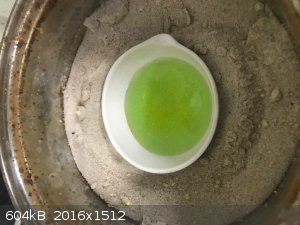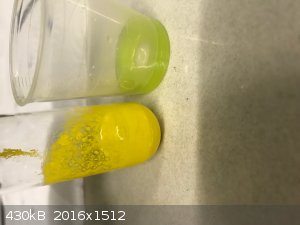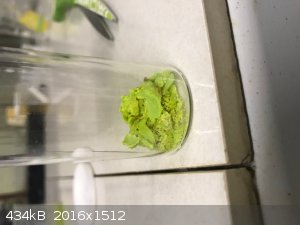
Lion850 - 7-4-2020 at 03:51
I was not going to make praseodymium iodide after seeing how short the 'shelf life' of erbium and neodymium iodide was but I could not find a
description of PrI3 anywhere so I had a go to see what the color was.
The first method was a double displacement between barium iodide and praseodymium sulfate. I dissolved iodine in barium hydroxide solution, this gave
a mix of barium iodide in solution and barium iodate precipitating out. This was then filtered to remove the barium iodate. Praseodymium sulfate was
then dissolved in the barium iodide solution.
I got a precipitate of presumably barium sulfate, and a green solution. The ppt was very fine, I could not filter it out! After multiple filtrations
the solution was still cloudy. This surprised me because I did not have this problem with barium sulfate the one previous time I did a double
replacement that gave barium sulfate.
I left the solution overnight. The ppt settled and the decanted (and again filtered) solution was clear. This was boiled down to a around 50ml and
filtered hot in case excess praseodymium sulfate came out of solution (low solubility in boiling water). The green filtrate was then placed in a
crucible in a desiccator.
After 3 days there was a moist green crust with some brown wet areas underneath. I wondered if the brown was barium iodide. At this point I had
already completed the second attempt (which follows below) so I decided to heat the crucible with the green and brown mix in a sand bath.
As a certain temperature was reached the green crystals also became brown. Then after some time with the sand being at >300C iodine fumes started
gassing off. This carried on for quite a while, and the crystals first became whitish and then brown. I suspect I ended up with praseodymium oxide
Pr6O11 and will investigate this further by trying to dissolve it is acid.
Second method.
While the final solution from method 1 was in the desiccator I tried another way. I dissolved 10g of praseodymium sulfate in 300ml water and then
added lead iodide PbI2. I have used PbI2 to prepare iodides with success before but it is a slow process because of the low solubility of PbI2.
I added the lead iodide in small batches interspaced by many hours of stirring, twice overnight. Each time I waited for the bright yellow solution
color to fade, showing the lead iodide was consumed, but in this case it was not as clear as usual. For some reason the color always faded only to a
pale yellow.
After a final 12 hour stirring the solution was filtered and yielded a nice clear green solution. The remainder was a fine powder of presumably lead
sulfate with a slight yellow tinge when wet but it because more white as it dried.
The solution was boiled down. It remained clear until the volume reduced to 140ml, then it became cloudy as the excess praseodymium sulfate fell out
of the boiling solution. I continued to boil it down to 30ml and then did a hot filtration. The resulting clear green solution should have had less
than 0.5g of sulfate left. See photo.
This green concentrate was heated in a crucible on the sand bath. It bubbled for a while but then settled. When the edges of the green liquid started
to go brown I removed the crucible from the heat and started to stir the contents with a glass rod. As it cooled it solidified into dry green flakes.
I did a few tests:
- The crystals was easily soluble in water (unlike praseodymium sulfate which takes time and stirring to dissolve).
- The crystals gave a green solution, and when lead nitrate was mixed with this solution a voluminous bright yellow ppt of lead iodide resulted. See
photo.
- The crystals are slightly hygroscopic, they became wet after a while when exposed to air.
So I have a green product that contains iodide. I assume this is most likely PrI3?
If anyone have access to references that described PrI3 can you please comment and tell me if it is described as being green?
See photo of the final product.



